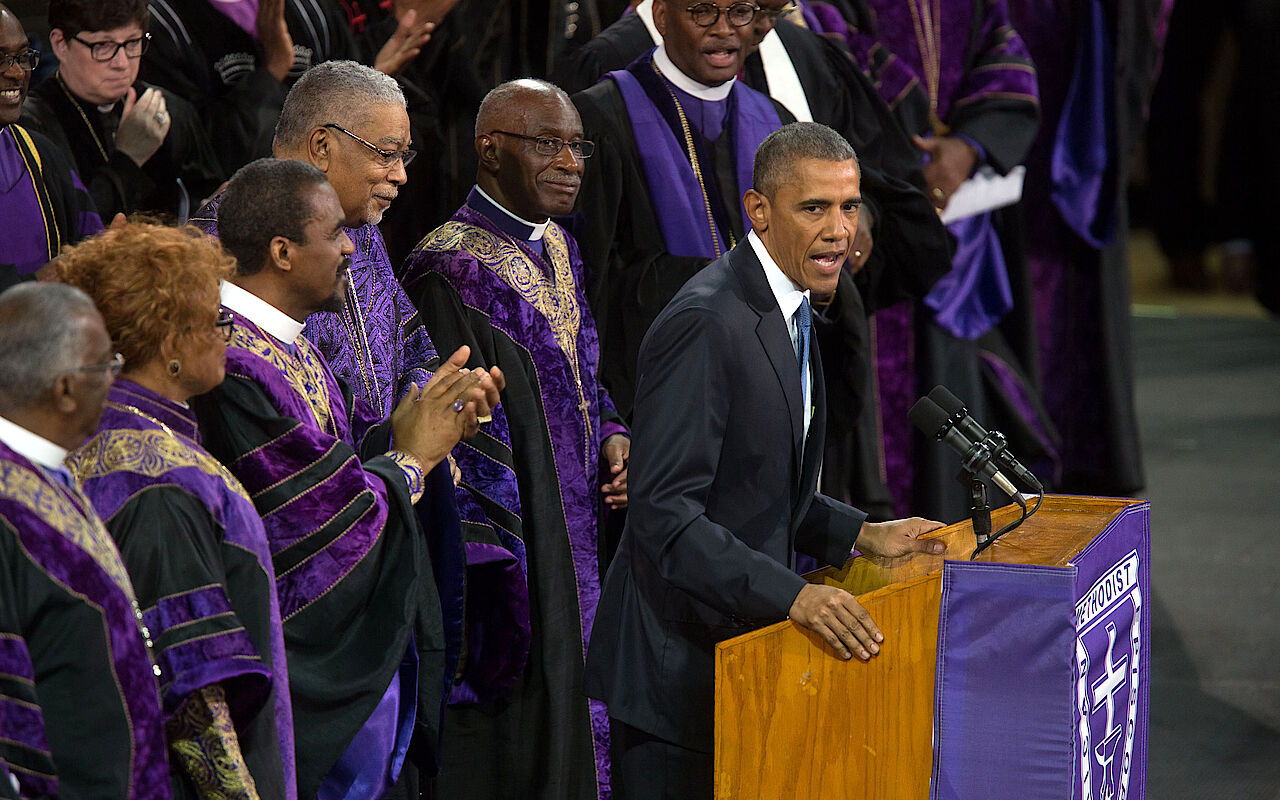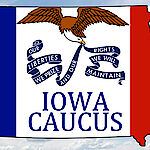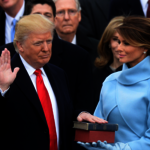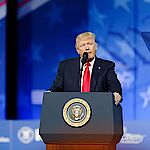Campaigning for the Presidency: Race and Religion as Oratorical Tools to Win the Election
The Atlantic Academy’s Road to the Elections No. 2
Daniela Hamann, Mainz University
About this Series
On November 8, nearly 200 Million registered voters are called upon to elect the next President of the United States of America, all 435 members of the House of Representatives as well as thirty-four of the one hundred senators. As in 2008, there is no incumbent, which is why both parties, the Democrats and the Republicans, will determine their candidates in primary elections. Thus, maybe fundamental changes but at least new accents in some policy fields should be expected.
With a monthly publication series, the Atlantic Academy will focus on this road to the elections in November. Political and economic scientists analyze policy fields as well as their roles in the (primary) elections and formulate expectations for a new presidency and Congress.
While the congressional elections have been hardly discussed in the various media outlets thus far, the presidential elections dominate all daily news broadcasts. Whenever it is time to elect a new President in the U.S., may it be after the first term of a current Commander in Chief, or when the presidency approaches its eight-year mark, a number of aspiring U.S. world leaders begin to speak publicly about the issues they deem most important for the future of the United States of America. Often, some of these issues are concerned with the flaws and mistakes of the current administration, or with matters of international cooperation, but the most important issues seem to be the ones that concern the people at home. Looking back at history, it becomes apparent that two concepts have always been on the list of presidential candidates: religion and race.
While both race and religion were also often responsible for the creation of a division among different groups of people (e.g. slavery, Civil Rights Movement, prejudices and hatred against Irish-Catholics, the discussions about John F. Kennedy’s faith) in the course of history, some presidential candidates and Presidents have also detected a certain potential to generate support and unity with the help of religion, as well as race.
Both, the concepts of religion and race are frequently used, directly as well as indirectly, by almost all candidates who present themselves through campaign publications and their oratory in the debates and appearances which lead up to the 2016 presidential elections. Yet, in my opinion, the candidates will have to meet a certain standard with regard to the two concepts, which has been established by President Barack Obama, in order to win the election.
When Barack Obama ran for the presidency, he often used race and religion in his oratory. In general, it can be noted that both concepts are closely entwined in the persona of Barack Obama. His definition of religion is all encompassing. He presents himself and his own views as an example, but ensures that all members can identify with his message by placing values, ethics and morals at the center, while additionally creating a point of compromise with agnostics and atheists. He constructs an overlap between religious philosophies on the one hand and between religion and atheism on the other hand. In that manner, and with mediation as his goal, Obama addresses the concerns of conservative Christians and secularists or progressives and acts as a moderator. Obama offers himself as a teacher in bilateral cooperation and his method, which I call a political/religious hybrid concept, as a tool to create consent. Moreover, Obama tries to convince the opposing parties to use the approach that he has already mastered in his political oratory: to create religious/political hybrids. This claim receives validation when looking at Barack Obamas final State of the Union Address on January 12, 2016. In this speech, Obama once more adheres to beliefs of unison and cooperation, even when disagreement is the most dominant topic on the political agenda, and the belief in universal tolerance that transcends race and religion. We “need to reject any politics that targets people because of race and religion. This isn’t a matter of political correctness. It’s a matter of understanding what makes us strong.” He continues with ”When politicians insult Muslims, when a mosque is vandalized, or a kid bullied, that doesn’t make us safer” (White House 2016). These words can be understood as a direct warning to all extreme right wing groups that have continued to harass U.S. Muslims more frequently since the recent attacks in Paris. Moreover, Barack Obama indirectly cautions presidential candidate Donald Trump who openly defamed Muslims in December of 2015.
In my dissertation, Concepts in Motion: Religion and Race in the Political Oratory of Abraham Lincoln, John F. Kennedy and Barack Obama[1], I have developed a notion that I call American civil race and that is based on Robert N. Bellah’s concept of American civil religion. In a nutshell, American civil race is a hybrid that consists of elements from the various racial categories, as well as political and cultural conventions and ideas. Like American civil religion, American civil race is not static but progresses and moves under the influence of social, political and historical events. As American civil religion was created as a tolerant and all-inclusive idea within the U.S. society, American civil race has been developed with the same aim, but on the level of differences of origins as opposed to differences of philosophies.
With regard to race, Obama is one of the contemporary figures that cause the impressive progress of the concept of American civil race: namely through his own public persona which, at the same time, is a symbol for American civil race. Obama unites black and white, but also tolerance, moral judgment and equality. The former is connected to his biological heritage while the latter is a result of his conviction and his aim to herald the beginning of a post-racial era in the U.S. He employs some of the ideas that have developed since the Civil Rights Movement and transforms them into thoughts that are independent from race and that concern all citizens. This is an important move for the progress of American civil race. Moreover, Barack Obama embodies a symbol within the development of American civil race. This symbolism allows him to act as a bridge (Cf. The Bridge. The Life and Rise of Barack Obama, by David Remnick) in a metaphorical sense (Cf. “Metaphor – The Bridge Between Feelings and Knowledge,” by Arnold H. Modell) and furthermore enables him to redefine the concept of race towards a new understanding – an American civil race. Like Martin Luther King Jr., Obama has recognized “that the destiny of black Americans” is “inextricably entwined with that of other Americans” (Carson 7). In his 2016 State of the Union Address, Obama therefore says, “I’ll be right there with you as a citizen – inspired by those voices of fairness and vision, of grit and good humor and kindness that have helped America travel so far. Voices that help us see ourselves not first and foremost as black or white or Asian or Latino, not as gay or straight, immigrant or native born; not as Democrats or Republicans, but as Americans first, bound by a common creed” (White House 2016). While his agenda is met with much criticism and resistance, Obama, like no other President before him, still promotes a post-racial, or better a post-discrimination (religion, skin color, life style) era and bi-partisan cooperation on all levels.
An extreme contrast to Barack Obama is presidential candidate Donald Trump. Both with regard to religion and race, he demonstrates a lack of tolerance and universality. He uses stereotypes and prejudices while verbally discriminating and fiercely insulting whole ethnicities (Mexicans) and members of religious philosophies (Islam). In December 2015, Donald Trump has voiced his intolerance towards members of the Islamic faith, calling to prohibit “all Muslims from entering the United States” (Diamond 2015). Prior to those statements, Trump had asked to put mosques under surveillance. He furthermore said, “he was open to establishing a database for all Muslims living in the U.S.” (Diamond 2015). With regard to race, Donald Trump has caused extreme outrage among Mexicans and Latinos, when, in September of 2015, he accused Mexico of “sending its ‘rapists’ and criminals to the U.S. and calling for a human-proof wall” to keep Latin Americans from crossing the border between Mexico and the U.S. (Estevez 2015). Yet, he did not stop at this point. Only a short time later, Trump called for the deportation of 11,3 million undocumented workers of which 6 million are Mexicans and demanded to deny babies born to unregistered immigrants their birthright of citizenship (cf. Estevez 2015). It can be safely said, however, that his statements are not publicly supported by any member of the Republican Party. Many of the other presidential candidates that run as “Republican” in the primaries have distanced themselves from Trump, especially Jeb Bush. Donald Trump won the primary in South Carolina and is currently the leading contender on the Republican listing. Some political analysts even claim that he has already won the Republican Nomination. This makes a great number of politicians – also on the Republican side – quite unhappy.
But perhaps the current situation is no reason to be miserable. This fact could turn out to be an advantage for the Democratic candidate running for President after the primaries. If the GOP nominates Trump, I find it very doubtful that he will win the general elections.
Even though she declared victory, the Iowa Caucus has shown that Hillary Rodham Clinton is currently quite close to competitor Bernie Sanders (not taking into account superdelegates at this point). Bernie Sanders won in New Hampshire, yet Clinton secured her victory in Nevada. Both candidate’s victories are within a 5% margin. Hillary Clinton’s stance on both religion and race seems to be in accordance with both Bellah’s American civil religion and my concept of American civil race. In August of 2015, Hillary Clinton appeared on Al Sharpton’s radio show “Keepin’ it Real.” In the interview, Clinton voiced her concern over the fact that the Voting Right Act was attacked by a number of politicians. She furthermore said “Congress needed to renew the act to protect voting rights for everyone” (cf. hillaryspeeches 2015). In early December of 2015, Hillary Clinton directly addressed Republican adversary Donald Trump. In a message that has been published on her official campaign site, she states that “Donald Trump has made a name for himself in this election by trafficking in prejudice and paranoia.” Since no presidential candidate before him has been so obviously ignorant and in defiance of political correctness (which I believe is a tactic that he uses to attract a certain voter clientele), Trump’s words are easy to target (within and from outside of his constituency). Therefore, Clinton addresses her words also towards other Republican candidates and observes “Ben Carson says that a Muslim shouldn’t be president. Marc Rubio compares Muslims to members of the Nazi Party” and “Jeb Bush and Ted Cruz have suggested that we implement a religious test for Syrian refugees – one that only Christians would pass” (cf. hillaryclinton 2015). By pointing out those negative comments, Clinton presents herself in a tolerant and all-inclusive manner similar to Barack Obama, but not quite as convincing as the current President of the United States.
In contrast to Hillary Clinton, Bernie Sanders addresses concerns of non-Caucasian ethnicities and young people (ages between 18 and 49) in the U.S. more directly. In a statement on his campaign site, he says that policies are necessary “to transform this country into a nation that affirms the value of its people of color.” He enumerates “five central types of violence” that African Americans, Latin Americans and Native Americans face: physical, political, legal, economic and environmental (cf. berniesanders 2016). If Hillary Clinton did not profit as much from her husband’s popularity as she did since the beginning of her ambitious political career, the race would not be as tight for the democratic contestants. Or more directly stated, without Bill, Hillary would not have a chance, other than the lack of other contestants.
Two months into 2016, it is still impossible to predict the outcome of the presidential elections. What can be foreseen, however, is that these upcoming elections will finalize an important era – the era of the first African American President of the United States of America. Moreover, the votes of the African-American and the Latino population will be more important than ever. Both groups combined represent a significant demographic. It is not easy to predict if the new President will be a “Minority-Majority President” like Obama. Yet, a new and equally important question will require a response: Will there be a first female President of the United States? Only time will provide the answer to this thought. What can already be observed, however, is that whatever the outcome of the upcoming elections, race and religion will not cease to continue to play an important role before and after this historical event
[1] The dissertation will come out soon in the Atlantic Academy’s publication series “Atlantische Texte”.
Bibliography
Bellah, Robert N. (1967). “Civil religion in America.” Daedalus. Vol. 96. 1-21.Berniesanders (2016). Racial Justice. berniesanders.com/issues/racial-justice/Carson, Clayborne (2011). “King, Obama, and the Great American Dialogue.” Essay send to Daniela Hamann by Clayborne Carson himself, via E-Mail on May 9, 2011. 1-12.Diamond, Jeremy (2015). “Donald Trump: Ban all Muslim Travel to U.S.” edition.cnn.com/2015/12/07/politics/donald-trump-muslim-ban-immigration/Estevez, Dolia (2015). “Debunking Donald Trump’s Five Extreme Statements About Immigrants and Mexicans.” forbes.com/sites/doliaestevez/2015/09/03/debunking-donald-trumps-five-extreme-statements-about-immigrants-and-mexico/ (2015) No, Donald Trump. We’re not barring Muslims from entering the country (December 2015), hillaryclinton.com/feed/no-donald-trump-were-not-barring-muslims-entering-country/Hillaryspeeches (2015). Clinton Appears on Al Sharpton’s Radio Show (August 2015), hillaryspeeches.com/2015/08/06/clinton-appears-on-al-sharptons-radio-show/White House (2016). President Obama’s 2016 State of the Union Address (January 2016), Washington (DC), medium.com/@WhiteHouse/president-obama-s-2016-state-of-the-union-address-7c06300f9726;
About the Author
In fall of 2009, Daniela Hamann finished her Master’s degree in American Studies, Political Science and English Linguistics at Johannes Gutenberg-University Mainz. In summer 2015, she received her PhD for her thesis, titled Concepts in Motion: Religion and Race in the Political Oratory of Abraham Lincoln, John F. Kennedy and Barack Obama. She currently works as officer of public affairs and event management at the Krebsregister Rheinland-Pfalz gGmbH, a sub-division of the medical department at Mainz University.







